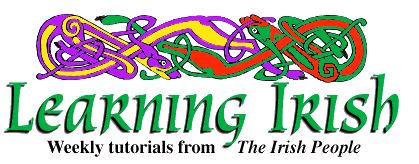
Irish Lesson 21
|
PRONUNCIATION In this lesson, we will begin a review of the elements of Irish pronunciation that you learned in the first 20 lessons. This will help those of you who did not join the lesson series at the beginning or who missed some of the lessons. Those who have followed all the lessons may benefit from the review, too, because additional notes and pointers will be given. In addition, next week, the complete pronunciation guide (from Lesson 1) will be reprinted. Our pronunciation guide (always in parentheses) represents Irish sounds by closely related English sounds. Where the difference is significant, an asterisk (*) will follow the letter symbol to let you know. Capital letters in the pronunciation guide mean an accented syllable or word. For example, our pronunciation guide would represent the English word "pronunciation" by (proh-NUHN-see-AY-shun). For consonants b, d, f, g, h, l, m, n, p, r, s, and t, the letters themselves serve. (k) is used for "c" where the "c" is pronounced as in English "cold". All these consonants except "h" have at least two sounds in Irish, depending on whether the nearest consonant is either a, o, u, or else e or i. You will learn these sounds as we progress. Since our pronunciation guide is a simplified compromise, we will run into odd-looking cases at times. For example, (keyent) may look strange at first, but a second look will tell you that it rhymes closely with English "pint". Then, too, (byuhg) is not (BEYE-uhg) but is closer to (bee-UHG) with a very short (ee) sound. Vowel sounds have a little more complicated system. Learn these first: (ah) as in English "ah-hah" (a) as in English "at" (e) as in English "let" (ee) as in English "seen" (i) as in English "pin" (eye) as in English "eye" (oh) as in English "toe" but with out the trace of (oo) at the end (oo) as in English "food" (uh) as in English "run" (u) as in English "put" (ou) as in English "shout" Two other vowel sounds are followed by asterisks to indicate difference from the common English pronunciation of the letters. The first sound is (ay*). Pronounce this like the first part of the vowel group in the English word "say", but omit the second part, a trace of (ee). Irish persons often carry this pronunciation into English. Recall to yourself how they would pronounce "say", "day", "pray". The second is (aw*). This sound is close to the way many Irish persons pronounce the vowel in "thaw", "awful", or "saw", although most Americans do not pronounce those three words that way. For Americans, the sound (aw*) in words like "tá" is closer to the "o" in "otter", "top", or "tot" but is held longer. In Irish spelling, the sound is represented by "á". Another way to get the (aw*) pronunciation is to watch your lips in a mirror as you say "awful", noticing that the lips are pushed far out. If you try the word with your lips help in closer and more rounded, you will be very close to the (aw*) in words like "tá". Now practice (aw*) in these words: ábalta (AW*-buhl-tuh) able, capable ál (aw*l) brood, progeny ár (aw*r) our áras (AW*-ruhs) a dwelling ádh (aw*) luck áit (aw*t) place álainn (AW*-lin) beautiful áil (aw*l) desire arán (uh-RAW*N) bread bán (baw*n) white dá (daw*) if mórán (moh-RAW*N) much GRAMMAR In Lessons 10 to 12, you learned how to answer the questions: Céard é seo? (kay*rd ay* shuh) what is this? Céard é sin? (kay*rd ay* shin) what is that? and to classify, that is, to say that a person or object is in some class or group. For example: "is dochtúir í" (is dohk*-TOO-ir ee ) means "She is a doctor", and "is bord é" (is bohrd ay*) means "it is a table". To identify a person or object as having a name or being the particular one that you are talking about, Irish has a slightly different form. Learn these examples by heart: Is mise Seán (is MISH-e shaw*n), I am John. ("Mise" is the emphatic form of "mé".) Is tusa Séamus (is TU-suh SHAY*-muhs), You are James. ("Tusa" is the emphatic form of "tú".) Is sinne na dochtúirí (is SHIN-ye nuh dohk*-TOO-i-ree), We are the doctors. Is sibhse na scoláirí (is SHIV-she nuh skoh-LAW*-ree), You (plural) are the pupils. Note that the word order is reversed from: Is dochtúir mise (is dohk*-TOO-ir MISH-e), I am a doctor. The same is true of "é seo" or "í seo" meaning "this", and or "é sin" and "í sin" meaning "that". For example: Is é seo Brian (shay* shuh BREE-uhn), This is Brian. Is í sin Bríd (shee shin breed), That is Bridget. This also holds true for "iad seo" (EE-uhd shuh), these, and "iad sin" (EE-uhd shin), those. An example is: Is iad sin Cormac agus Una (SHEE-uhd shin KOHR-muhk AH-guhs OON-uh), Those are Cormac and Una. The annoying part, however, is that with "é", "í", and "iad" alone, a doubling of the pronoun occurs, as in: Is é Brian é (shay* BREE-uhn ay*), It's Brian Is í Máire í (shee MAW*-re ee) It's Mary. Is iad na fir iad (SHEE-uhd nuh fir EE-uhd), They are the men. Is iad Peadar agus Dónall iad (SHEE-uhd PAD-uhr AH-guhs DOHN- uhl EE-uhd), They are Peter and Donald. This will be clumsy and annoying to you at first, but persevere and you will develop the proper thought pattern, so that the right phrase will come to you quickly in any situation. (c) 1997 The Irish People. May be reprinted with credit. |